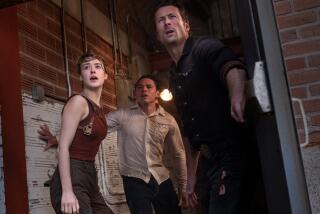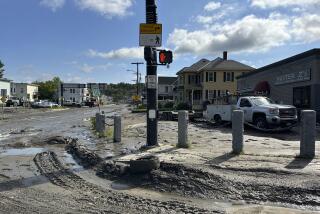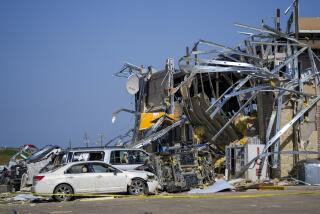In tornado-struck Massachusetts, it feels like Missouri
Reporting from Springfield, Mass. — This isn’t Missouri, where TV news stations show the wreckage left by the tornado that roared through Joplin. It isn’t Alabama, where a deadly twister tore through Tuscaloosa five weeks ago. But it might as well have been for Mary Talley, who watched in agony Thursday as her family’s home was laid bare for all to see, from the laundry basket in the bedroom to her son’s black pastoral robe.
Few of the stunned onlookers snapping pictures of the spectacle took notice of Talley, leaving the tiny 73-year-old woman with a cane to quietly grieve for the yellow house that was reduced to ruins by a tornado that left a swath of Massachusetts in shambles.
“It was wonderful. I was happy here,” she said, wiping tears away as a bulldozer heaved aside chunks of wood, dirt and shredded remnants of the Talleys’ lives.
At least three tornadoes tore through the region Wednesday, killing at least three people, injuring dozens and blindsiding residents who thought blizzards were the worst punishment Mother Nature could mete out in this bucolic region.
“That’s why we always say we love New England. No earthquakes like in California. No tornadoes like you see in Missouri,” said Paul Bailey, who used to live in Springfield and was visiting the city when the storms hit.
In fact, tornadoes regularly swing through here, but rarely are they powerful enough to kill. The last one to cause fatalities was in 1995, and the dead were in Great Barrington, 70 miles away. This time, the dead were Springfield’s close neighbors: a woman in West Springfield who was killed protecting her 15-year-old daughter, who survived; and man in West Springfield killed when a tree fell onto his van; and a third person in nearby Brimfield. A fourth death was initially reported in Springfield, but Gov. Deval Patrick said it was still being investigated and may have been caused by a heart attack.
Even if the tornadoes didn’t kill on a grand scale, they destroyed. From tiny Monson, which lost its church steeple, to Springfield’s Main Street, the damage was startling and the memories as dramatic as the heart-stopping video that showed one twister sucking water out of the Connecticut River as it barreled toward downtown Springfield.
“We just kind of looked out the window and said, ‘That doesn’t look good,’ ” said Mia Robbins, who works on the 14th floor of a glass building overlooking the river. She ran for the building’s basement. April Payeur kicked off her stilettos and followed. They were safe but shaken.
So was Tyrone Holt over on Pine Street Court, a cul-de-sac lined with old, wood-framed houses. Holt was on the front porch enjoying the evening with two friends when everything changed. The wind came up. Leaves began swirling. Darkness set in, even though it was still afternoon. They ran for the basement, grabbing their children, two poodles and a giant pet tortoise as wind “like a lion’s roar” thundered outside, said one of the friends, Glenda Montana.
Holt’s girlfriend, Giovanna Marquez, was driving home with her sister and infant niece, listening to the radio. Amid the crackling reception, they heard something about a tornado, but they couldn’t be sure what was said through the static. By the time the storm was upon them, it was too late to do anything but head for the local mall. They were herded into the basement with others just as one of the tornadoes hit.
In the minutes after the storm, Holt emerged onto a wasteland of downed trees, dangling power lines, disfigured houses and smashed cars. A neighbor called for someone to help rescue his mother and brother, who were trapped in a house that had been partially pulled from its foundation and slammed back down nearly on its side. Both were among the 200 people the governor said were injured.
Where some homes were devastated, others stood in pristine condition, save for the dust floating on a cool wind Thursday that left neighborhoods covered in a grayish grime. A shard of metal slammed through Holt’s house and some windows were broken, but otherwise it was intact.
Yet a few feet away, two neighbors’ homes had been tossed like toys. Next to them, another house was untouched. Even the potted plants and ceramic frog on its porch were in place.
Clyde Talley, Mary Talley’s son and an ordained minister, was out with his wife when the tornado hit. He grew up in the yellow house on Beech Street and bought it from his mother a few years ago, when she moved into a nearby retirement home. They were grateful that nobody was home Wednesday evening when the tornado struck.
“It looks like it got lifted up and dropped back down,” Clyde Talley said as the bulldozer continued its work, occasionally taking a break to let family members grab items of value. While driving home through the wind Wednesday night, Talley said he heard there had been a tornado and that the house had been hit.
He expected to see some roof tiles blown off. Instead, he found a huge chunk of the roof missing, walls gone, the floor collapsed, and officials telling him the structure was too dangerous to enter.
“We watch this on TV all the time, but when it hits home,” his mother said, her voice trailing off. “I don’t know. You can’t find the words.”
Meanwhile, in Missouri, officials updated the death toll from the tornado that hit Joplin on May 22 to 138 people. The state Department of Public Safety said the toll rose after four people died in hospitals of injuries from the deadliest single tornado in the U.S. since 1950.
At least 1,425 tornadoes have been reported this year in the United States. In an average year, 1,376 tornadoes form. Scientists say warmer-than-average temperatures in the Gulf of Mexico, and a stronger-than-usual jet stream, are among the factors contributing to the unusually high numbers.
“It’s an eye-opener,” Miriam Santiago-Arce said as she watched the Talley home being dismantled. She pondered whether science, or something else, was responsible for the spate of global disasters lately, including twisters, floods, tsunamis and earthquakes.
“I’m not religious or anything,” she said. “But you wonder, what’s going on?”
More to Read
Sign up for Essential California
The most important California stories and recommendations in your inbox every morning.
You may occasionally receive promotional content from the Los Angeles Times.











